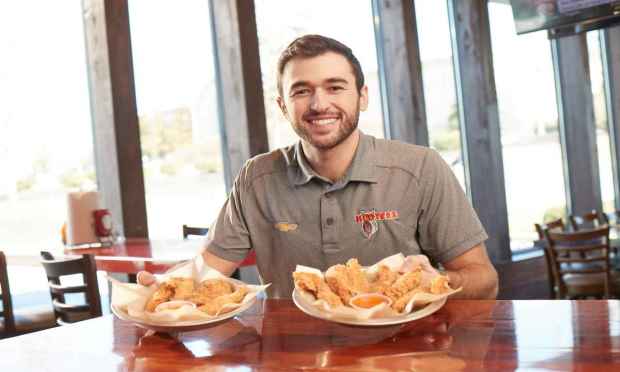Hooters Adds 196 Virtual Locations to Drive New Sales

With Hooters’ latest launch, the restaurant chain is taking its customers at their word when they say they come for the food. The brand, which has more than 400 restaurants across the country and abroad, announced Monday (Oct. 31) that it is adding a virtual brand, Chase Elliott’s Chicken Tenders, in partnership with celebrity racecar driver Chase Elliott.
The virtual chain is launching in 196 locations across the United States’ most popular aggregators — DoorDash, Uber Eats and Grubhub. In addition to the eponymous tenders, the brand also sells boneless wings and various other fried foods.
“Virtual concepts have been an important part of our off-premises growth strategy since 2019,” Marc Butler, senior vice president, strategic planning/off-premise at Hooters of America, said in a statement. “Hooters is very well known for our great wings, but awareness is lower for other menu segments such as tenders, burgers and seafood. Incorporating Chase into this virtual concept will help us create greater awareness [and] attract a new audience.”
The news comes as major restaurants seek to boost their revenue with the addition of virtual restaurants, driving more sales from their existing kitchens and equipment and boosting their margins.
For instance, Chili’s Grill & Bar parent company Brinker International has rolled out its It’s Just Wings concept, and Dickey’s Barbecue Pit has done the same with Wing Boss. Chuck E. Cheese, meanwhile, has its Pasqually’s Pizza & Wings brand.
These brands were all made possible by the widespread adoption of digital ordering seen in the last few years. In fact, around half of all consumers across financial lifestyles now purchase food online, according to data from the August edition of PYMNTS’ monthly ConnectedEconomy™ study, “Paycheck-To-Paycheck Consumers Digitally Disengage.”
The report, which drew from a June survey of a census-balanced panel of 2,760 U.S. consumers, found that 46% of consumers who do not live paycheck to paycheck, 55% of those who do so comfortably, and 57% of those who do so with difficulty had engaged with restaurants online at least once in the previous 30 days.
Get the study: The ConnectedEconomy™ Monthly Report: Paycheck-To-Paycheck Consumers Digitally Disengage
Additionally, when brands tailor their virtual offerings to different timings than their typical menus, they have the opportunity to use these brands to drive sales at off-peak hours, better utilizing their existing labor without straining capacity.
For instance, Alex Canter, CEO of virtual restaurant company Nextbite, noted to PYMNTS’ Karen Webster in a June interview that the company has taken this approach with popular casual dining chain IHOP.
“With IHOP, for example, they’re 24/7 at the majority of their locations, but they’re really busier in the mornings than they are at night,” Canter said. “So, we’ve designed two concepts for them: a grilled cheese concept and a quesadilla brand that is performing exceptionally well from 9 p.m. to 5 in the morning.”
With the Hooters example, customers might typically come to the restaurant at mealtime, but they may order mozzarella sticks late at night. Yet according to the Jacksonville, Florida, location of Chase Elliott’s Chicken Tenders, the brand accepts orders from 11am to 11:29pm, which is nearly identical to the restaurant’s hours.
These hours suggest that it is currently not the brand’s intention to cater to entirely new timings, but peak times may nonetheless prove different for the virtual brand than the brick-and-mortar restaurant.
